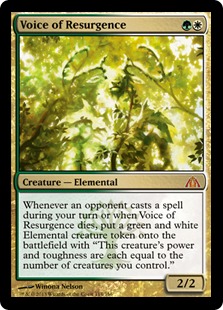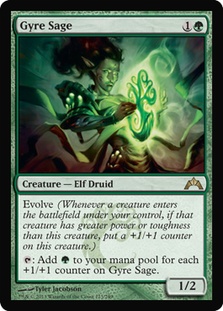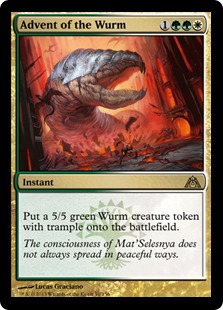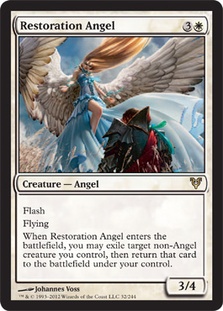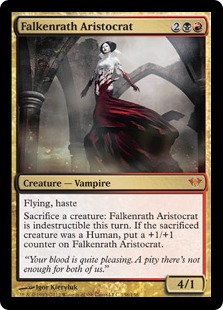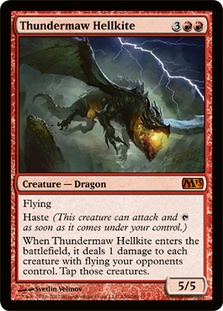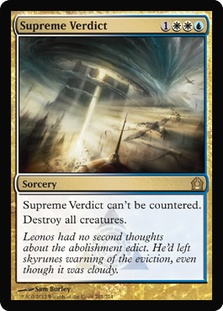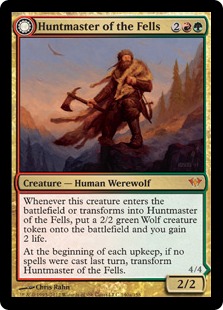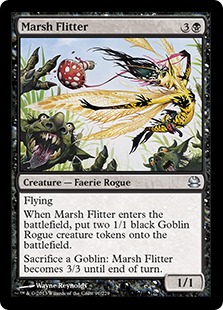Constant motion is the defining feature of the current Standard format. Naya Aggro was at the top just a week ago, but last Saturday’s Naya decks were completely different—and well suited to beat last week’s favorite. The same is true for other decks; you can find four sideboarded Pillar of Flames in Jund or even maindeck ones in the resurgent U/W/R decks. Voice of Resurgence and Strangleroot Geist are powerful, but no one can stand against an overwhelming amount of enemies—even the Spartans in 300 couldn’t.
The cost of loss is much smaller these days, so Naya Aggro has a chance to return to the top tables (I wouldn’t be surprised if it didn’t because its mana base is very inconsistent), but the new favorites are faster, higher, and stronger than the previous ones. Let’s look at what to play and, among other things, what to play if you want to spend 60 dollars for something bigger than a 2/2 for two.
The rise of aggressive decks predictably led to a higher midrange presence, but this time we have something new—Naya can easily match Jund in card quality. That’s rarely the case because the Jund colors generally include better removal, but who needs many removal spells if you can just attack with the best creatures? That’s the primary difference; Jund is about efficient removal and good finishers and is generally defensive, while Naya is about overpowered creatures and defends itself by blocking rather than by using removal.
Creatures (27)
- 4 Avacyn's Pilgrim
- 3 Restoration Angel
- 4 Thundermaw Hellkite
- 3 Flinthoof Boar
- 3 Loxodon Smiter
- 2 Experiment One
- 4 Boros Reckoner
- 4 Voice of Resurgence
Planeswalkers (4)
Lands (24)
Spells (5)

Look at Matt Hoey’s Top 16 Naya deck from SCG Standard Open: St. Louis. He played the same maindeck as Willy Edel at GP Guadalajara and slightly tweaked the sideboard. Heavier Naya quickly became more popular than the lighter one on Magic Online, and now parity is restored in real life Magic too! All the best creatures are here, and Voice of Resurgence allows something that Burning-Tree Emissary doesn’t—the ability to go over the top.
However, I’m still worried about the deck’s ability to cast one-mana creatures on time, even if it’s mitigated by the fact that acceleration is still fine on turns 2 and 3. Eric Froehlich’s similar deck from the Top 8 of Pro Tour Gatecrash didn’t include any one-mana creatures, and I think that’s still the correct decision just to optimize early plays.
Will Gyre Sage oust Avacyn’s Pilgrim? It has its own weaknesses, but it fits into the mana curve better, can attack without the help of Gavony Township (which is hard to incorporate into an already weak mana base) and, most importantly, doesn’t require playing basic Forests to be castable. Decks with Burning-Tree Emissary tried to be as aggressive as possible, so there was always a conflict between Sage and Emissary; that’s much simpler with Voice of Resurgence, which is good at any stage of the game. I’d build Naya this way:
Creatures (27)
- 1 Huntmaster of the Fells
- 3 Restoration Angel
- 4 Thundermaw Hellkite
- 3 Flinthoof Boar
- 3 Loxodon Smiter
- 1 Aurelia, the Warleader
- 4 Gyre Sage
- 4 Boros Reckoner
- 4 Voice of Resurgence
Planeswalkers (4)
Lands (24)
Spells (5)

The deck’s mana curve has a little emphasis on heavier costs (I also considered Wolfir Silverheart to accompany Thundermaw Hellkite) and is fine for growing Gyre Sage and preparing for turn 4 Thundermaw Hellkite. Aurelia, the Warleader is added as an additional hasty flying threat to make the deck better positioned against multiple blockers (Lingering Souls is still all around) and to win some games out of nowhere.
The rest of the deck is pretty straightforward, but I’d note the Huntmaster of the Fells to defend yourself, Ray of Revelation for Bant Hexproof, and the fact that Rest in Peace is here more for The Aristocrats/Junk Aristocrats than for Junk Reanimator because you want to beat Angel of Serenity by being fast and creating enough pressure before they start blinking Acidic Slime.
I somewhat dislike the lack of Advent of the Wurm in the list, but Restoration Angel has the advantage of being a creature, which is important for Domri Rade. Some Wurms may make their way into the list, but 27 creature cards is close to the minimum where Domri is still good, so the only realistic swap is to cut Selesnya Charm, decreasing our ability to deal with opposing fatties that we can’t match with our threats.
However, Gyre Sage is best with Varolz, the Scar-Striped, and a well-built Jund Aggro deck is very good against heavier Naya builds (and light ones too). Voice of Resurgence is a powerhouse, but the combination of Burning-Tree Emissary and Gyre Sage is good enough to match it, while black over white gives us a great hasty evasive threat in Falkenrath Aristocrat and better removal if needed. The most significant downsides of going Jund are the lack of the Boros Reckoner + Blasphemous Act combo and Assemble the Legion, but both aren’t crucial and having twice as much hasty fliers is significant.
Creatures (30)
- 2 Borderland Ranger
- 4 Arbor Elf
- 4 Falkenrath Aristocrat
- 4 Thundermaw Hellkite
- 3 Flinthoof Boar
- 4 Burning-Tree Emissary
- 3 Ghor-Clan Rampager
- 4 Gyre Sage
- 2 Varolz, the Scar-Striped
Planeswalkers (3)
Lands (23)
Spells (4)

This deck seems fine against all versions of Naya and Junk Reanimator, even if I’d like to be a little bit faster against the latter. Maindeck Domri Rade helps provide an advantage in creature battles and beat the occasional control deck, while Varolz, the Scar-Striped ensures that your creatures will be better than opposing ones—including various similar G/R Aggro decks with Gyre Sage and Hellrider.
The Jund Midrange matchup isn’t as good as I’d like it to be, but that’s the cost of being good against other the powerhouses of the format. In contrast to Naya, Jund Midrange has enough removal to suppress early aggression, and things become worse after sideboarding since the best you can do is to become similar deck with worse options. Similar to Jund Midrange, it also appears to have no weapons against Bant Hexproof. It’s sad, but at least we have the ability to outrace them even without Unflinching Courage. We don’t have enough removal to use Glaring Spotlight profitably, and there is no reason to try Thragtusk (Bant Hexproof is also Tusk-proof), so racing is probably the best way to minimize losses here.
Speaking of Jund Midrange, let’s take a quick look at Joey Mispagel and Caleb Durward’s 75, which they piloted to Top 8 and Top 16 finishes in St. Louis.
Creatures (11)
Planeswalkers (3)
Lands (25)
Spells (21)

No Sire of Insanity anywhere, four copies of Pillar of Flame in the sideboard, maindeck Bonfire of the Damned—just everything to beat aggressive decks and be fine against Junk Reanimator. I’ve never wanted to play Jund in this format, but I like this list a lot; the only change I’d make is to put Sire of Insanity in the sideboard. The recent success of midrange decks may lead to control’s return (three of them just made the Top 8 in St. Louis, and Joey Mispagel lost in the quarterfinals to U/W/R). Moreover, the current metagame is friendly to Turbo Fog, and the time is right for someone to catch people off guard soon.
From the other side, the addition of Sire of Insanity to the maindeck makes the deck a pile of good cards that the pilot needs to draw in the proper order and in the proper matchups. That’s why I generally dislike the deck, so it seems right to put Sire of Insanity in the sideboard and build a more consistent maindeck.
Nevertheless, Jund Midrange is fine but not an outstanding choice right now—it clearly isn’t the best midrange deck anymore. If Naya can match it with the quality of its creatures, couldn’t other ideas work too? One of these ideas is to build heavier midrange or even something between midrange and control. This slot is traditionally filled by U/W/R Flash, but I don’t think that Sphinx’s Revelation’s based decks are well positioned right now because of Voice of Resurgence.
The way that could work is a kind of tapout board control deck with specific answers to aggression and planeswalker-based advantage to match the lack of Sphinx’s Revelation. Another reason to think this way is that there are few reasons to play Supreme Verdict right now—it’s trumped by almost all aggressive decks (even Bant Hexproof has adapted by playing Strangleroot Geist and Voice of Resurgence).
Maybe later…
That’s why I tried different RUG builds. They combine the power of Jace, Architect of Thought and Ral Zarek with Huntmaster of the Fells, Thragtusk, and efficient removal to create as many two-for-ones as possible. The same could be done in Grixis, but green gives us life gain, Farseek, and an army in a card—Huntmaster of the Fells—that is important in early defense. Would Grixis match RUG if Marsh Flitter were legal? Who knows, but it would be something to talk about, while Vampire Nighthawk isn’t in the same league as Huntmaster.
The next important question is the finisher of choice. You must be able to win games relatively fast to beat Junk Reanimator and to avoid sudden Boros Reckoner Blasphemy, so I like having some Thundermaw Hellkites over Aetherling just to start swinging a couple of turns before drawing the seventh land. Ral Zarek helps, but I still prefer the DRAGON right now, especially since I have Izzet Staticaster to deal with annoying blockers like post-Dragon Lingering Souls.
Creatures (13)
Planeswalkers (5)
Lands (24)
Spells (18)

The plan is simple: use some early removal, stabilize, and then kill them. Another strength of the deck is its ability to reboard in the most deadly manner against a given opponent. You can add more removal against aggro, Cavern of Souls and Garruk, Primal Hunter against control, and use the combination of Acidic Slime and Progenitor Mimic to always be ahead on resources against Junk Reanimator and midrange decks. The Slime + Mimic game plan seems attractive enough to build a deck around it, but the best shell is probably Four-Color Reanimator, where Boros Reckoner and Faithless Looting seem like a better reason to distort the mana base.
Glaring Spotlight rounds out the sideboard as a necessary tribute to Bant Hexproof. The deck didn’t do well in St. Louis, but a metagame full of various midrange decks is insanely friendly to Geist of Saint Traft, so you should be ready for Auras. Red, blue, and green aren’t the best colors for that since we hardly have anything better than Naturalize (and can only dream about Ray of Revelation), so Glaring Spotlight is our weapon of choice.
That’s all for today; be aware of Voice of Resurgence and Geist of Saint Traft, and good luck to everyone playing this weekend in Columbus and other places around the world! As usual, ideas and suggestions are welcome.

